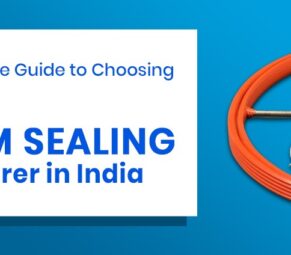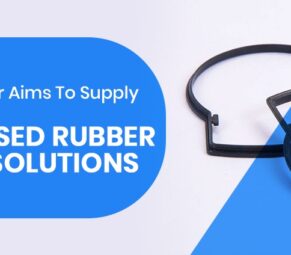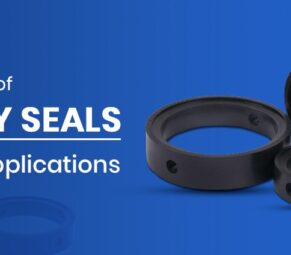1) Nitrile Butadiene Rubber (NBR)
NBR is a synthetic copolymer composed of butadiene and acrylonitrile. It is extensively preferred due to its resistance to fuels, oils, and other chemicals.
Salient Features:
- Oil resistant
- High mechanical strength
- Mean compression set
- Abrasion-resistant
- Weather-resistant and low aging
Common Applications:
- Oil seals
- Disposable non-latex gloves
- Footwear and floor mats
- Automotive, marine, and aeronautical fuel and oil systems
- Adhesives
- Belts, hoses, O rings, gaskets
Properties:
- Hardness: 30-90 Shore A
- Temperature resistance: -30° C to + 100° C (+ 120° C)
- Standard colors: Black
Advantages:
NBR performs exceptionally well in vegetable oils, aliphatic hydrocarbons, petroleum-based oils, and fuels, silicone oils, dilute acids, water (below 100°C), and ethylene glycol.
Limitations:
- May oxidize when in contact with strong oxidizers.
- NBR compounds are prone to automotive brake fluid, ketones, esters, ozone, aldehydes, aromatic hydrocarbons, ethers, and strong acids.
2) Hydrogenated Nitrile Butadiene Rubber (HNBR)
HNBR is a synthetic polymer that is created by saturating nitrile’s butadiene segments with hydrogen. It is popularly known for its toughness and resistance to chemicals, heat, oil.
Salient Features:
- Oil resistant
- Excellent mechanical properties
- Abrasion-resistant
- Low compression set
- Hot air resistant
- Cold flexibility
- Weather and ozone resistant
Common Applications:
- Industrial applications
- Automotive air conditioning systems
- Oil resistant applications
- Static and dynamic hoses, belts, and seals
- Seals for oil well processing and exploration
Properties:
- Hardness: 50-90 Shore A
- Temperature resistance: -30° C to + 150° C (+ 175° C)
- Standard colors: Green, Black
Advantages:
HNBR exhibits good performance in ethylene glycol, vegetable oils, silicone greases, and oils, aliphatic hydrocarbons, dilute acids, steam, or water (up to 150°C), salt solutions, and petroleum-based fuels and oils.
Limitations:
HNBR compounds are prone to strong acids, ketones, esters, ethers, and chlorinated hydrocarbons.
3) Ethylene Propylene Diene Monomer Rubber (EPDM)
EPDM is a copolymer of propylene and ethylene, amalgamated with a terpolymer of propylene, ethylene, and diolefin to allow sulfur vulcanization.
Salient Features:
- Good elasticity
- Weather-resistant
- Aging, heat and cold resistant
- Chemical resistant
- Low compression set
- Steam and hot water-resistant
Common Applications:
- Solar panel heat collectors
- Weather-resistant uses
- Electrical insulation
- Automotive seals
- Automotive brake and cooling systems
- Garden appliance such as hose, tubing, washers, belts
Properties:
- Hardness: 30-90 Shore A
- Temperature resistance: -40° C to + 130° C
- Standard colors: Black
Advantages:
EPDM performs exceptionally well in ketones, steam (up to 204°C), alkalis, alcohol, automotive brake fluid, silicone greases, and oils, dilute alkalis, phosphate ester-based hydraulic fluids, weathering, and ozone.
Limitations:
EPDM compounds are prone to halogenated solvents, hydrocarbon fluids, aromatic and aliphatic hydrocarbons, petroleum-based greases and oils, and di-ester-based lubricants.
4) Chloroprene Rubber (CR)
CR is created by emulsion polymerization of chloroprene. It is a multi-purpose rubber that provides a balanced combination of properties. It is widely known for its good resistance to fire and outstanding toughness.
Salient Features:
- Aging and ozone resistant
- Cold flexibility
- Good resistance to ammonia and refrigerants
Common Applications:
- Automotive industry
- Cable and wire industry
- Gaskets for air condition systems
- Oil, heat, and flame resistant applications
Properties:
- Hardness: 40-80 Shore A
- Temperature resistance: -35 °C to + 100 °C
- Standard colors: Black
Advantages:
- CR is known for its resilience, resistance to degradation by ozone and oxygen, high tensile strength, and oil and flame resistance.
- It performs well in ammonia, aniline point mineral oil, silicone oils and grease, water, and refrigerants.
Limitations:
CR compounds are prone to esters, chlorinated hydrocarbons, ketones, ethers, aromatic hydrocarbons, and strong oxidizing acids.
5) Fluoro Rubber (FKM)
FKM is a popular high-performance rubber that has great resistance to organic solvents, chemicals, mineral oil, oxygen, hydraulic fluids, fuels, ozone, high temperatures, and aromatics.
Salient Features:
- Good tear strength
- Flame retardant
- Ozone, oxygen, and weather-resistant
- Chemical and heat resistant
- Low gas permeability
- Cold flexibility
- Low compression set
Common Applications:
- Industrial applications
- O-rings
- Automotive applications
- Aerospace applications
- Chemical processing
Properties:
- Hardness: 50-90 Shore A
- Temperature resistance: -20° C to + 200° C (+ 250° C)
- Standard colors: Black
Advantages:
FKM performs exceptionally well in mineral oil and grease, fuels or blends with ethanol or methanol, high vacuum environments, strong acids, ozone, and petroleum products.
Limitations:
FKM compounds are prone to acetic acids, superheat steam, chlorosulfonic acids at high heat, amines, formic acid, ketones, hydrofluoric, nitro hydrocarbons, and phosphate ester-based hydraulic fluids.
6) Perfluoro Rubber (FFKM)
FFKM is known to exhibit superb resistance to chemicals and high temperatures. Specific grades of FFKM also display maximum continuous service temperature (up to 327° C).
Salient Features:
- Excellent resistance to ketones, esters, and amines.
- High-temperature resistant
- Chemical resistant
Common Applications:
- Used in the manufacture of gaskets and o-rings
- Highly corrosive fluids applications
- Hydrocarbon applications
- Extreme temperature applications
Properties:
- Hardness: 60-90 Shore A
- Temperature resistance: -15° C to + 260° C (+ 320° C)
- Standard colors: Black
Advantages:
- One of the highest temperature resistant materials in the market.
- Can be molded into x-rings, o-rings, and a variety of custom shapes.
- Can be available in different colors and compounds targeted for specific markets and applications.
- Shows good chemical resistance to most chemicals.
Limitations:
FFKM compounds are prone to dynamic applications and molten alkali metals.
7) Natural Rubber (NR)
NR is mainly created from the latex of the Hevea tree, and its chemical name is polyisoprene. NR is extremely waterproof and is known for its excellent tensile strength and resilience.
Salient Features:
- Good resistance to cutting or tearing
- Abrasion-resistant
- High tensile strength
- Fatigue-resistant
Common Applications:
- Electrical applications
- Rubber hose and tubing
- Tires
- Rubber gaskets and seals
- Dampeners
Properties:
- Hardness: 40-90 Shore A
- Temperature resistance: -50°C to 70°C
- Standard colors: Black
Advantages:
- Performs exceptionally well in alcohols and organic acids
- High stretch ratio
- Low-level damping
- Excellent dynamic performance
Limitations:
- Poor resistance to hydrocarbon oil
- Not suitable for oxygen and ozone applications
- Poor weathering resistance
8) Silicone (VMQ)
Silicone, also known as vinyl methyl rubber (VMQ) is composed of elements that are derived from quartz. This synthetic elastomer is created by attaching pendant organic groups like vinyl, methyl, and phenyl to silicon atoms.
Salient Features:
- Cold flexibility
- Heat and Hot air resistant
- Ozone and weather resistant
- Excellent elasticity
- Great gas permeability
- Oil and solvent resistant
- Chemical resistant
Common Applications:
- Medical systems that require compliance to USP CLASS VI
- Automotive systems like oil filter valves and boots
- Food and beverage industry
Properties:
- Hardness: 30-80 Shore A
- Temperature resistance: -60° C to + 200° C
- Standard colors: Rust
Advantages:
- Performs remarkably well in dry heat, dilute salt solutions, ozone environments, transmission oil (mineral oil) and engine, and moderate temperature water.
- Anti-adhesive surface features.
- Exhibits good dielectric and physiological properties.
- Possesses high thermal resistance.
Limitations:
Does not perform well in ketones, steam environments (over 120° C ), concentrated alkalis, petroleum oil, and concentrated acids.
9) Fluorosilicone (FVMQ)
FVMQ is a durable elastomer that shares the mechanical properties and temperature stability of silicone (VMQ). However, compared to standard VMQ, FVMQ has better resistance towards mineral oil, fuels, and solvents.
Salient Features:
- Chemical resistant
- Compression set resistant
- Extreme temperature performance
- High thermal resistance
Common Applications
- Aviation fuel seals
- Automotive fuel seals
- Static sealing applications
- Diaphragms, o-rings, seals, gaskets, and hose lining
Properties:
- Hardness: 45-80 Shore A
- Temperature resistance: -60° C to + 200° C
- Standard colors: Blue
Advantages:
FVMQ compounds work well with aromatic hydrocarbons, benzene. fuels, toluene, aromatic mineral oils, ozone, and weather applications.
Limitations:
FVMQ compounds are prone to hydrazine, brake fluids, and ketones.











